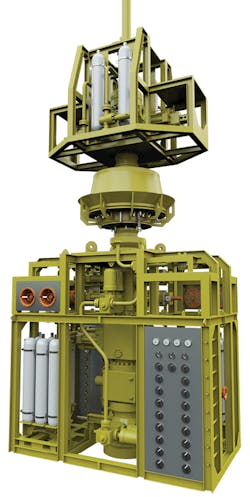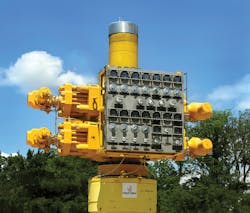Redesigned light well intervention system targets subsea P&A efficiency
Second-generation can easily switch between riserless and riser-based deployment
Andrew Barry
Thomas Wilke
Wild Well Control
Wild Well Control is bringing new and alternative well intervention methods with its improved, second-generation 7Series system. The company’s approach to plugging and abandonment (P&A) involves leaving the casing in place, and placing competent, tested cement plugs in the outer annuli of a well. The redesigned 7Series light well intervention (LWI) system will be lighter and more compact and feature more functionality and flexibility. Being able to switch between riserless and riser-based deployment functions without resurfacing will provide significant time savings and cost benefits. All subsea wells are potential candidates for this technology.
The second-generation 7Series will allow switching between riserless and riser-based deployment functions without resurfacing. (All images courtesy Wild Well Control)
This technology, along with changing market conditions, allows for major cost savings. The year 2016 was a banner one for decommissioning in the deepwater Gulf of Mexico, where a little more than $1 billion was spent to abandon wells. Operators still had drilling rigs under contract that were idle. According to Wood Mackenzie, companies put the rigs to work abandoning wells, rather than spending $150 million on an exploration well. That activity level pulled back in 2017, and is expected to keep falling through 2018 as rigs come off contract and abandonment costs decline. However, with the decline in rates for both rig and multi-purpose support vessels (MPSV), the competition for being the deployment vessel of choice heated up, which further impacted the costs of well intervention.
Rig operators are looking for ways to enhance their capabilities and work scope, so aligning with an LWI provider such as Wild Well, affords them the opportunity to take on work that might otherwise have gone to an MPSV. The scale and scope of a MODU lends itself well to operating as an LWI deployment asset, given its great fluid storage and solids handling capabilities. Coupling that with the reduction in time to deploy a LWI system versus their traditional drilling riser and stack makes the MODU a significant competitor to the MPSV fleets.
The second-generation system will be more compact, and will allow for installation on a traditional semisubmersible or drillship, as well as vessels. The dimension changes in the second-generation system will allow for easier transportation, offshore mobilization, and installation. The company said that operators could reduce their P&A liabilities by about 50%.
The 7Series involves multiple Wild Well technologies and techniques, including DeepRange, a riserless P&A tool. The DeepRange tool is run in conjunction with the 7Series to allow perforating and circulating plugging material through an outer annulus, rather than perforating and squeezing or cutting and pulling casing.
The company also built a stand-alone subsea shut-in device for deployment with the 7Series. This device puts barriers in place while pulling tubing in open water. The subsea shut-in device can be deployed with either the generation one or generation two 7Series.
The biggest change in the second-generation system will be its ability to allow operators to switch “on the fly” between riserless and riser-based deployment functions without resurfacing. The decision to use which deployment function depends on the operations needed for a well. Some operations cannot be completed using wireline, such as milling out a plug or cleaning out a wellbore with sand. Light well intervention calls for slick or wireline, while medium well intervention needs coiled tubing.
The subsea shut-in device is an operational safeguard during open water tubing retrieval operations.
To date, the generation one system has been used on five campaigns, including an eight-well abandonment campaign offshore West Africa, and a temporary two-well abandonment program in the Gulf of Mexico for Anadarko. Additionally, Wild Well successfully deployed its first-generation system to plug and abandon nine Marubeni wells in the Gulf of Mexico. Marubeni then asked the company to deploy the system to perform a live intervention on a tenth well, where the system was used to swap production from a zone that had depleted to another zone.
For the second generation of the 7Series, the company is incorporating major lessons learned from the Marubeni well campaign. More specifically, deployment and recovery times for the company’s riserless grease head/lubricator posed a significant portion of overall operational time for the Marubeni campaign last year. The second-generation riserless grease head/lubricator, the company says, will achieve at least a 50% time-savings.
While the first-generation circulation system worked well overall for the Marubeni campaign, the company decided to redesign the system to reduce rig up time, and to be heave compensated.
Wild Well also has recertified the first-generation system, which gives it a complete new bill of health from the original equipment manufacturers for another five years. Also, it will be compliant with the API’s 17G recommended practice, which sets out design and operational principles for completion/workover riser systems.
Well mechanics are a key component to a successful and efficient P&A, or live well intervention. Addressing technical challenges in a subsea environment comes with the territory, and nothing can be taken for granted. With the second-generation riserless/risered “switch on the fly” system nearing completion, advances in efficiencies, improvements, and expansion of capabilities will provide significant time saving and cost benefits.





